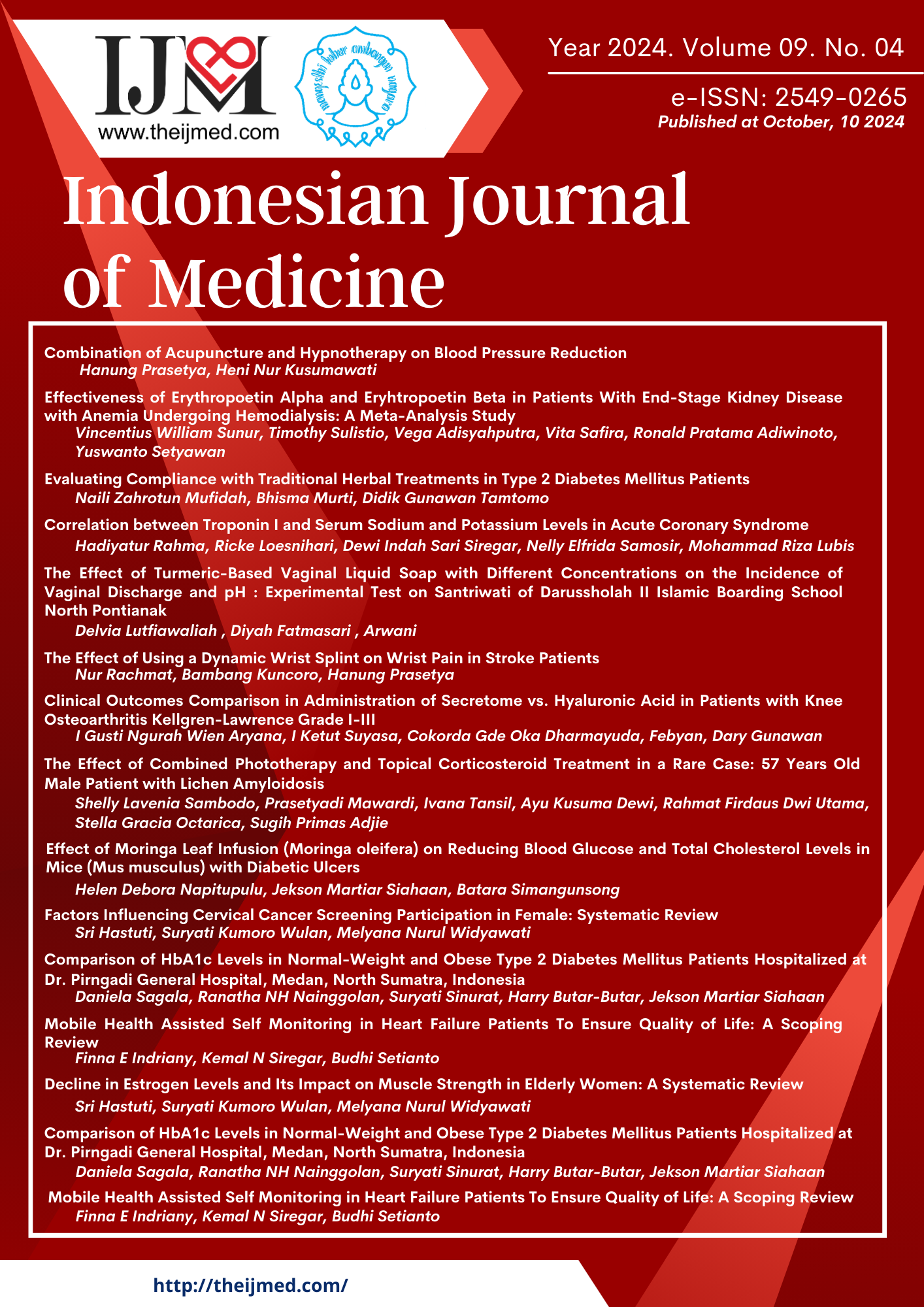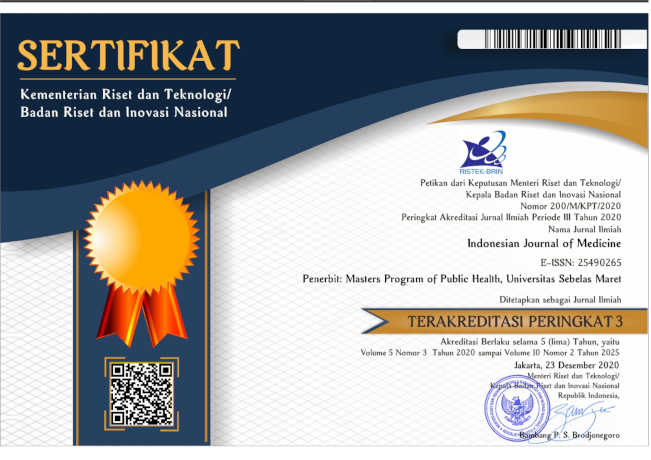Factors Influencing Cervical Cancer Screening Participation in Female: Systematic Review
DOI:
https://doi.org/10.26911/theijmed.2024.9.4.801Abstract
Background: Cervical cancer is the second leading cause of morbidity and mortality in the world. This can be influenced by several things such as lack of willingness to participate in cervical cancer screening. This review aims to explore factors that influence participation in cervical cancer screening.
Subjects and Method: This study is a systematic review with PICO covering: (1) Population: women; (2) Intervention: factors influencing participation; (3) none; (4) level of participation in cervical cancer screening. The databases used are PubMed and JSTOR. Inclusion criteria include full text in Indonesian and English with research subjects in women with cervical cancer. Exclusion criteria in this study were articles published less than five years ago.
Results: A total of 21 articles stated that several factors such as interpersonal, intrapersonal, community, organizational, and public policy can influence participation in cervical cancer screening.
Conclusion: Intervention strategies based on the reviewed factors need to be improved to reduce cervical cancer morbidity and mortality rates.
Keywords:
Cervical cancer, participation, screening, elderly womenReferences
Ago BU, Efiok EE, Abeng SE (2022). Socio-demographic and gynecological factors that influence uptake of cervi-cal cancer screening: A cross-sectional study in Calabar, Nigeria. Afr Health Sci. 22(4 PG-96–103):96–103. doi:10.4314/ahs.v22i4.13.
Akokuwebe ME, Idemudia ES, Lekulo AM, Motlogeloa OW (2021). Determi-nants and levels of cervical cancer screening uptake among women of reproductive age in South Africa: evidence from South Africa Demographic and health survey data, 2016. BMC Public Health. 21(1 PG-2013):2013. doi: 10.1186/s12889-021-12020-z.
Al-Amro SQ, Gharaibeh M, Oweis AI (2020). Factors associated with cervical cancer screening uptake: implications for the health of women in Jordan. Infect Dis Obstet Gynecol, 2020(PG-9690473): 9690473. doi:-10.1155/2020/9690473.
Alam Z , Ann Dean J and Janda, M (2022). Cervical screening uptake: A cross-sectional study of self-reported screening attitudes, behaviors and barriers to participation among South Asian immigrant women living in Australia. Womens Health (Lond). 18(PG-17455057221096240) doi: 10.-1177/17455057221096240.
Amin R, Kolahi AA, Jahanmehr N, Abadi AR, Sohrabi MR (2020). Disparities in cervical cancer screening partici-pation in Iran: across-sectional ana-lysis of the 2016 nationwide STEPS survey. BMC Public Health. 20(1 PG-1594): 1594.doi: 10.1186/s12889-020-09705-2.
Ampofo AG, Adumatta AD, Owusu E, Newton KA (2020). A cross-sectional study of barriers to cervical cancer screening uptake in Ghana: An appli-cation of the health belief model. PLoS One. 15(4 PG-e0231459): e023-1459. doi: 10.1371/journal.pone.023-1459.
Ba DM, Ssentongo P, Musa J, Agbese E, Diakite B, Traore CB, Wang S, Maiga M (2021). Prevalence and determi-nants of cervical cancer screening in five sub-Saharan African countries: A population-based study. Cancer Epi-demiol. 72(PG-101930): 101930. doi: 10.1016/j.canep.2021.101930.
Bante SA, Getie SA, Getu AA, Mulatu K, Fenta SL (2019). Uptake of pre-cervi-cal cancer screening and associated factors among reproductive age women in Debre Markos town, Northwest Ethiopia, 2017. BMC Public Health. 19(1 PG-1102):1102. doi:10.1186/s12889-019-7398-5.
Chan DNS, So WKW (2017). A systematic review of the factors influencing eth-nic minority women’s cervical cancer screening behavior: From intraper-sonal to policy level. Cancer Nursing. 40(6):E1–E30. doi: 10.1097/NCC.00-00000000000436.
Chandrika K, Naik BN, Kanungo S (2020). Awareness on cancer cervix, willing-ness, and barriers for screening of cancer cervix among women: A com-munity-based cross-sectional study from urban Pondicherry. Indian J Public Health. 64(4 PG-374–380): 374–380. doi: 10.4103/ijph.IJPH_2-9_20.
Diendéré J, Kiemtore S, Coulibaly A, Tougri G, Ily N, Kouanda S(2023). Low attendance in cervical cancer screening, geographical disparities and sociodemographic determinants of screening uptake among adult women in Burkina Faso : results from the first nationwide population-based survey. Rev Epidemiol Sante Publique. 71(4 PG-101845): 101845. doi: 10.1016/j.respe.2023.101845.
Donatus L, Nina FK, Sama DJ, Nkfusai CN, Bede F, Shirinde J, Cumber SN (2019). Assessing the uptake of cer-vical cancer screening among women aged 25-65years in Kumbo West Health District, Cameroon. Pan Afr Med J. 33(PG-106):106. doi: 10.116-04/pamj.2019.33.106.16975.
Fentie AM, Tadesse TB, Gebretekle G B (2020). Factors affecting cervical cancer screening uptake, visual ins-pection with acetic acid positivity and its predictors among women attend-ing cervical cancer screening service in Addis Ababa, Ethiopia. BMC Womens Health. 20(1 PG-147): 147. doi: 10.1186/s12905-020-01008-3.
Gelassa FR, Nagari SL, Jebene DE, Belgafo D, Teso D, Teshome D (2023). Know-ledge and practice of cervical cancer screening and its associated factors among women attending maternal health services at public health insti-tutions in Assosa Zone, Benishangul-Gumuz, Northwest Ethiopia, 2022:a cross-sectional study. BMJ Open, 13(5 PG-e068860): e068860. doi: 10.1136/bmjopen-2022-068860.
Gemeda EY, Kare BB, Negera DG, Bona LG, Derese BD, Akale NB, Kebede KM, Koboto DD, Tekle AG (2020). Prevalence and predictor of cervical cancer screening service uptake among women aged 25 years and above in Sidama Zone, Southern Ethiopia, using health belief model. Cancer Control. 27(1 PG-107327482-0954460). doi: 10.1177/1073-274820954460.
Ibeanu O A (2011). Molecular Pathogenesis of Cervical Cancer. Cancer Biology and Therapy. 11(3): 295–306.
Isabirye A (2022). Individual and intimate-partner factors associated with cer-vical cancerscreening in Central Uganda. PLoS One. 17(9 PG-e02746-02): e0274602. doi: 10.1371/journal.-pone.0274602.
Natae SF, Nigatu DT, Negawo MK, Meng-esh WW (2021). Cervical cancer screening uptake and determinant factors among women in Ambo town, Western Oromia, Ethiopia: Commu-nity-based cross-sectional study. Cancer Med. 10(23 PG-8651–8661):8651–8661. doi: 10.1002/cam4.4369.
Novalia V (2023). Kanker Servik. GALENI-CAL : Jurnal Kedokteran dan Keseh-atan Mahasiswa Malikussaleh. 2(1): 45.
Phaiphichit J, Paboriboune P, Kunnavong S, Chanthavilay P (2022). Factors associated with cervical cancer screening among women aged 25-60years in Lao People’s Democratic Republic. PLoS One. 17(4 PG-e026-6592): e0266592. doi:10.1371/jour-nal.pone.0266592.
Maria SN, Olwit C, Kaggwa MM, Nabirye RC, Ngabirano TD (2022). Cervical cancer screening among HIV-positive women in urban Uganda: across sec-tional study. BMC Womens Health. 22(1 PG-148):148. doi: 10.1186/s129-05-022-01743-9.
Sung H (2021). Global cancer statistics 2020: globocan estimates of incidence and mortality worldwide for 36 cancers in 185 countries. Ca Cancer J Clin. 71(3): 49–209.
Wakwoya EB, Sadi CG, Sendo EG (2023). Precancerous cervical lesion screening acceptance among women in Eastern Ethiopia. BMJ Open. 13(11 PG-e073721): e073721. https://doi.-org/10.1136/bmjopen-2023-073721.
Weng Q, Jiang J, Haji FM, Nondo LH, Zhou H (2020). Women’s knowledge of and attitudes toward cervical cancer and cervicalcancer screening in Zanzibar, Tanzania: a cross-sectional study. BMC Cancer. 20(1): 63. https://doi.org/10.1186/s12885-020-6528-x.











